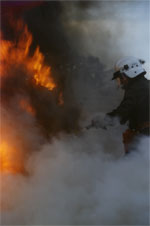 The race consists of four laps, each of which is 100 meters long. Each team member has a right to run one lap only. The stem is considered as a baton. To pass the baton it exists passing zone of 20 meters length. Determining factor here is position of the stem, not the competitor. The competitor taking the baton from previous one may start ten meters before the passing zone. The stem could be passed in any mode. The last competitor has to cross the finish line with the stem in his hand. In the case of falling of the stem during passing it, it may be picked up only by the passing competitor. If the pipe falls down on the neighboring track it is allowed to pick up without impeding other competitors. Otherwise the team may be disqualified. The race consists of four laps, each of which is 100 meters long. Each team member has a right to run one lap only. The stem is considered as a baton. To pass the baton it exists passing zone of 20 meters length. Determining factor here is position of the stem, not the competitor. The competitor taking the baton from previous one may start ten meters before the passing zone. The stem could be passed in any mode. The last competitor has to cross the finish line with the stem in his hand. In the case of falling of the stem during passing it, it may be picked up only by the passing competitor. If the pipe falls down on the neighboring track it is allowed to pick up without impeding other competitors. Otherwise the team may be disqualified.
The competitor who has passed on the baton (stem) to the next competitor may leave the track after making sure that he doesn't impends to other participants. Any help to the competitor on the lap is prohibited. Violated team should be disqualified.
Firefighting relay-race stages are as follows:
a) a competitor stands by start line with stem and pole ladder;
b) a competitor starts on Starter's signal or command. For next laps a competitor starts without additional command right after baton is passed;
c) first lap: A competitor runs up to the house (the hurdle), climbs up to the top of it with pole ladder, runs to the end of the roof, jumps down to the track so that he should reach the ground behind the limiting line. If he jumps down before the limiting line he has to return and overcome the hurdle again;
d) second lap: after the baton is passed second competitor should overcomes the barrier while it is not allowed to step on stands and slopes. As he jumps down fuel in the pan gets kindled;
e) third lap: the competitor takes the stem, runs up to hoses, takes them and overcomes the beam (carrying the pipe and the hoses), then runs up to the branching, joints hoses to it lays it. Hoses may be carried in any mode. Joining hoses with each other and joining it to stem may be performed on spot or on the run. Stem should be joint to hose before "uncoupling line", and should be uncouple after the line. Position of hoses after uncoupling of stem doesn't make difference. If the competitor jumps off the beam before the limiting line he has to return and overcome it again. When the stem is handed over to the 4th lap runner all coupling half nuts should be joint; No one is allowed to touch the hoses after the "Start" signal and the start pistol shot;
d) fourth lap: the competitor takes the stem, runs to fire extinguisher, takes it and extinguishes the burning pan. It is prohibited to leave the fire extinguisher in the pan after fire has been extinguished. Track Judge of fourth lap should set the extinguisher. If the fire can't be extinguished by one fire extinguisher, the competitor has to use back up one.
Finish: The task is completed if the competitor with the stem crosses the finish line and all fire in the pan and around it is extinguished.
In the International competitions all pans must be heated by burning 0, 25 liters of petrol before the first round has started.
|